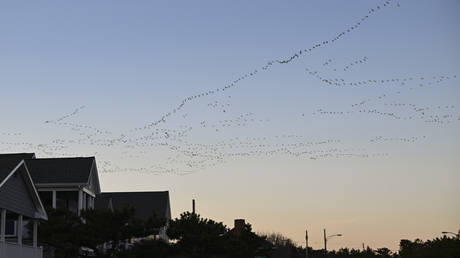
Data recorded by observing bird flight patterns with artificial drones can be used by aviation industry, researchers say
A team of scientists in the US state of New Mexico has undertaken a novel approach to studying the animal kingdom: by attempting to install drones into dead, taxidermied birds as part of an experiment designed to understand more about their flight patterns.
“We came up with this idea that we can use dead birds and make them [into]a drone,” Dr. Mostafa Hassanalian, an associate professor at the New Mexico Institute of Mining and Technology, told Reuters this week. “Everything is there. We do reverse engineering.”
Hassanalian and his team came up with the unconventional idea after failing to see the desired results when they flew artificial mechanical ‘birds’ in flocks of living animals. The taxidermied bird drones are currently being tested in a customized cage – but can at present only be flown for around 20 minutes at a time.
It is hoped that the project will shed new light on how birds conserve energy by flying in certain formations when the artificial drones are flown alongside living flocks. This data could potentially be applied to streamline human aviation.
“If we learn how these birds manage energy between themselves, we can apply [that]into the future aviation industry to save more energy and save more fuel,” Hassanalian told Reuters. It is also hoped that the testing will further articulate theories about how the colors of birds interact with flight efficiency.
“We’ve done experiments and determined that, for our fixed-wing aircraft, applying a certain color can change the flight efficiency,” said another scientist, Brenden Herkenhoff. “And the same is true for birds, we believe.”
Bizarrely, the nature of the study appears to coincide with the popular (and deliberately facetious) conspiracy theory ‘Birds Aren’t Real’, which has for several years stated that birds are in fact artificial drones flown in the sky to spy on people. The movement has followers in numerous countries worldwide and has spawned a popular line of apparel.
Hassanalian, though, maintains that his study has no nefarious intentions: “I actually did not know about the people of ‘Birds Aren’t Real’. I found out about them once my story came out for the first time.”




